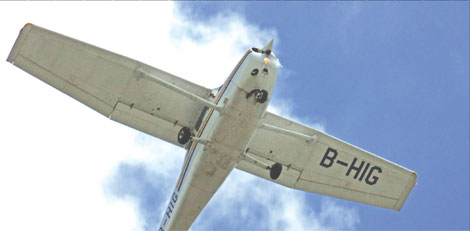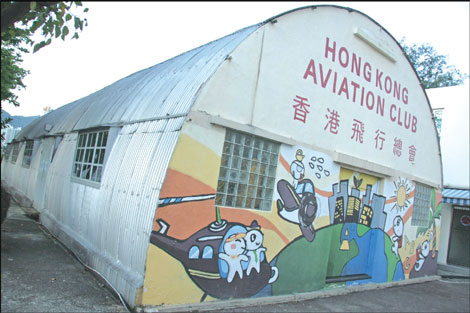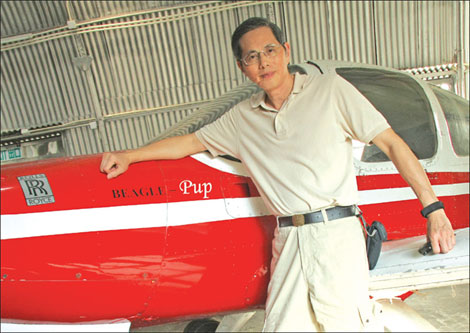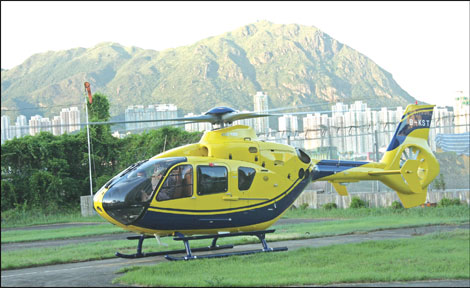Up in the air
Updated: 2010-07-13 07:47
By Doug Meigs(HK Edition)
|
|||||||
|
A single-engine airplane flies above the New Territories. Recreational pilots are required to remain within the airspace of the Hong Kong SAR. Provided to China Daily |
|
The Hong Kong Aviation Club is located on the edge of the former Kai Tak International Airport. Provided to China Daily |
|
Francis Chin is one of Hong Kong's most famous recreational pilots. Provided to China Daily |
|
Club members fly helicopters from the old Kai Tak International Airport. Provided to China Daily |
Recreational helicopter and fixed-wing pilots have only two flying sites in Hong Kong. The oldest - at Kai Tak - may soon disappear. Doug Meigs reports.
Helicopters soar high above the fringe of the otherwise defunct Kai Tak International Airport. They leave daily from a tiny patch of grass and asphalt behind the clubhouse in Kowloon.
During weekends, when the People's Liberation Army's Hong Kong Garrison isn't using the runway at Shek Kong Airfield, club members zoom over New Territories in single-engine airplanes.
The Hong Kong Aviation Club (HKAC) enjoys a monopoly on recreational flying in Hong Kong. However, members may be soon limited to Shek Kong as redevelopment increases at Kai Tak.
The HKAC is an amalgamation of two former clubs. The Hong Kong Flying Club (started in 1929) and Aero Club of Hong Kong (started in 1933) merged in 1982 to form the current organization.
It has more than 300 full-member pilots, who fly the club's four helicopters and seven fixed-wing aircraft. Some members also own private planes or helicopters, which they store at Kai Tak or Shek Kong.
Local instructor Francis Chin Yiu Cheong is among the club's most senior pilots. He was a 16-year-old in 1966, when he joined the club and earned his pilot's license.
Chin recalls being the only Chinese member of the club, aside from a mixed Portuguese-Chinese member, until he convinced his five brothers to learn how to fly.
He and his brother Dominic completed the first single-engine aircraft flight from London to Hong Kong in 1972. More recently, last November, he flew from Hong Kong to Xi'an to promote aviation on the mainland.
After retiring from a career in audiology, Chin became a vocal advocate for preserving Kai Tak Airport. He formed a "Save Kai Tak" campaign in 2003 and petitioned the government to preserve 799 meters of runway for educational aviation use. The request was dismissed in the final Kai Tak Planning Review in 2007.
President of the HKAC, John Li, said the club's main goal is to provide a forum for aviation enthusiasts, and to help them go airborne.
"I don't deny the fact that a lot of us just fly for fun or the love of flying, and there's absolutely nothing wrong with that," he said. The club also engages in youth outreach activities through the Air Scouts, Air Cadet Corps, scholarships and other programs.
The club and its predecessors were always based at Kai Tak. Now, construction crews are beginning to transform the vast expanse of empty prime real estate. In a few years, the once-upon-a-time logistical air hub of Southeast Asia will boast a towering residential complex, a behemoth cruise terminal and sports facilities.
Height limitations imposed by Kai Tak's runway disappeared after the airport ceased formal operations in 1998. Skyscrapers began sprouting around the neighborhood long ago.
Ironically, Kai Tak's redevelopment will take the grounds closer to their originally intended purpose.
"Kai Tak" gained its name from two developers, Ho Kai and Au Tak, who had reclaimed the land in a failed residential development scheme.
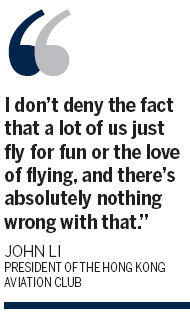
The first tenant, "Crazy" Harry Abbott, established a flying school there in 1924, thus establishing an aviation enthusiasts' foothold on the land.
"In the '60s and '70s, that was the golden era of flying in Hong Kong. In the '80s, flying became more difficult," Chin said.
Kowloon's population surged, and urban development ballooned. Kai Tak's congested air traffic became a traffic controller's nightmare choked in an iconic urban setting.
Chin said the British Royal Air Force welcomed the flying club to Shek Kong, and they moved all fixed-wing aircraft a few years before the airport closed to commercial air traffic. The last passenger plane left Kai Tak in 1998, when the new international airport opened at Chek Lap Kok.
"Chek Lap Kok does not welcome general aviation, or pilot training," Chin said. "Or, let me put it another way: they leverage a huge cost for doing so. So this club had nowhere else to fly but Shek Kong."
Li said the club knew all along that the government would not maintain the runway at Kai Tak for flying and that they would not have a place at the new international airport.
"Between '94 and '97, the RAF pulled out, but the PLA hadn't arrived yet," he said. "In those three years, the old Shek Kong airbase was government property, and they charged us HK$100,000 a month rent, which almost broke the club. Then when the PLA came, we renegotiated."
Chin said that the renegotiation was possible because of Hong Kong's Basic Law, which stipulated maintaining the status quo for 50 years. Chin said other flying groups would not enjoy the same access to Shek Kong because no other groups were using the airfield before the handover.
Li said the PLA provides runway use to the club free of charge. "All over China you would not have such a mix of civilian and military use in an airbase, so we are very grateful," he said.
During the past decade at Kai Tak, many remnants of the commercial airport have disappeared. Meanwhile, helicopter flying has become increasingly popular at the site.
Li said about a third of the club's active pilots fly helicopters. The club has issued helicopter licenses since the late '90s, after Li earned his instructors certification in the UK.
He said that before he began training helicopter pilots, there were only 10-15 helicopter pilots in Hong Kong. Helicopter popularity has helped maintain continued use of Kai Tak for aviation.
Resident flying instructor Ken Lau explained the attractions of either aircraft:
"The thrill of flying a helicopter is that you are constantly busy, your hands and feet are always occupied, but in a fixed-wing, there are times when you can let go and just fly."
Li wants the club's helicopter pilots to continue flying at Kai Tak for as long as possible, but he is a realist.
"It (may be) imminent that we will stop flying from Kai Tak, just purely because of the development of this part of Kowloon," he said. "Is it going to put an end to general aviation? I don't think so. I think if there's a will, there's a way."
After years of devotion to his "Save Kai Tak" campaign, Chin has accepted the airport's fate as outlined in the 2007 development plan.
He said some of his proposals are noted in the document: lower density of buildings, preservation of the Kai Tak control tower, plans for an aviation museum.
Whether the government and developers proceed accordingly has yet to be seen; however, he is optimistic about plans to build a heliport at the end of the old runway.
"If it will be purely commercial or open to general aviation, that remains up to the next generation of enthusiasts to fight for," he said.
(HK Edition 07/13/2010 page4)
